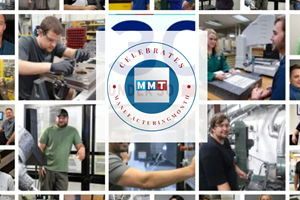Training on the Plastics Side of Moldmaking
There are specific topics on the plastics side of moldmaking that should be covered in a training program.
An effective moldmaking training class not only addresses the practical considerations for building plastic injection molds, but also covers the theoretical reasons for doing what moldmakers do. It is important to convey more than just what moldmakers do to build a robust mold. Moldmakers need to ensure students understand why they do it as well.
With that concept in mind, this piece outlines some of the specific topics that should be covered in a training program. (With permission, this piece primarily derives content from a webinar-based class that moldmaking industry expert, Randy Kerkstra, teaches.)
Mold components. Apprentices should learn about mold components and relevant terminology early on in their training. They should be able to visually identify parts and explain their general purpose. Examples include ejection components such as pins, plates, slides and lifters, core pins, bushings, leader pins, springs, slide retainers, latch locks, parting line pullers and safety straps. Also, the apprentice must be able to correctly identify the mold half on which he or she is working. This means understanding the cavity versus the core, the A-plate versus the B-plate and the cover versus the ejector.
Mold material selection. Apprentices need to understand the pros and cons of various mold materials, as the mold material that the moldmaker uses depends on the application and the component. For example, an apprentice must understand why a mold is designed with a P-20 cavity block and HH P-20 slides and lifters, or vice versa. In another example, an apprentice must understand what circumstances result in the use of soft material, such as aluminum, brass or cold rolled steel, over a hardened H-13 material. The class should cover the materials used for gibs, wear plates and gate inserts too.
Temperature control. Apprentices must realize that a mold requires a means to control the process temperature, as well as why and how this is conducted. Controlling the process temperature involves in-depth instruction on proper water circuit design and the necessary parts and components, including fittings, plugs, bubblers, ISO pipes and baffles. A focus on temperature control system maintenance is recommended also.
Venting. Since one of the most important aspects of an efficient plastic injection mold is venting, it is vital for apprentices to understand its impact on the molding process. Understanding venting includes understanding everything from the overall vent design to specific characteristics like the land, relief and depths. Apprentices must understand how to achieve proper venting using stationary inserts, ejector pins, sleeves and cores, which includes the role of Porcerax and sintered vent inserts.
Parting lines and support. Apprentices should come away from class with a strong understanding of the parting line in a mold, which includes recognizing shut-off areas to help them grasp the importance of locking and location concepts. They also need to learn how to properly support all of the parting line areas of the mold to prevent flex and injection pressure issues, as these problems contribute to flash.
Surface finishes. Achieving the appropriate mold surface finish is another key training area. It should include a focus on a finish’s impact beyond the impression that it leaves on a plastic part. Additionally, training should look at the variety of texture, media, blasting, coating and polishing types, sticking issues and part holding methods.
Spotting. In addition to covering design concepts, training should cover some practical tips and techniques related to spotting. Training should include the use of the various spotting tools, as well as their proper handling and care. Go over the idea of true net during the training on spotting tools. Be sure to put emphasis on proper spotting of slides and lifters.
Hot runners. Apprentices need a general understanding of hot runners. Technicians that have advanced beyond the apprentice level can continue to learn about hot runners, which represent a specialized area. A general understanding for apprentices includes the ability to recognize the various systems, components and applications. The apprentice should understand why and when to use a hot runner, the function of its heaters, thermocouples, hot drops and tip styles.
The apprentice should understand why and when to use a hot runner, the function of its heaters, thermocouples, hot drops and tip styles.
For an apprentice, understanding a tip’s bearing surfaces and its cooling issues is critical.
Hydraulics. Many plastics injection molds incorporate hydraulics, so apprentices must learn when and why they are used, recognize the various cylinder types and know how to choose the proper cylinder for the application at hand. Additionally, apprentices should be able to identify and explain hydraulic sensors, switches, mounting methods, rod connections and fittings, and they should be able to use basic hydraulic formulas.
Runners and gating. Apprentices should be able to recognize the different types and applications of runners and gates. Also, they should understand cavity filling, which requires a knowledge of gate geometry. And, learning about the various runner types and geometries will help them understand plastic flow.
Mold types. Apprentices will likely see an array of work come through a shop, so training should include an overview of the various mold types and their applications. Examples include three-plate, two-shot, stack, unscrewing, thermoform and blow molds.
About the Contributor
Ryan Pohl
Ryan Pohl is founder of Praeco Skills LLC.
Related Content
Leading Mold Manufacturers Share Best Practices for Improving Efficiency
Precise Tooling Solutions, X-Cell Tool and Mold, M&M Tool and Mold, Ameritech Die & Mold, and Cavalier Tool & Manufacturing, sit down for a fast-paced Q&A focused on strategies for improving efficiencies across their operations.
Read MoreThe Role of Social Media in Manufacturing
Charles Daniels CFO of Wepco Plastics shares insights on the role of social media in manufacturing, how to improve the “business” side of a small mold shop and continually developing culture.
Read More30 Under 30: The New Face of Moldmaking
Young professionals are vital to the moldmaking industry, and it is important to acknowledge those making strides in shaping the industry's future. MoldMaking Technology recognizes the industry's young talent through its inaugural 30-Under-30 Honors Program.
Read MoreICYMI: MMT Chats: True Leadership Leads to Mentoring, Part 1
This trio from TK Mold and Engineering in Romeo, Michigan, joins me to discuss the role of leadership and culture in mentorship. This episode is brought to you by ISCAR with New Ideas for Machining Intelligently.
Read MoreRead Next
How to Use Continuing Education to Remain Competitive in Moldmaking
Continued training helps moldmakers make tooling decisions and properly use the latest cutting tool to efficiently machine high-quality molds.
Read MoreAre You a Moldmaker Considering 3D Printing? Consider the 3D Printing Workshop at NPE2024
Presentations will cover 3D printing for mold tooling, material innovation, product development, bridge production and full-scale, high-volume additive manufacturing.
Read MoreHow to Use Strategic Planning Tools, Data to Manage the Human Side of Business
Q&A with Marion Wells, MMT EAB member and founder of Human Asset Management.
Read More

























